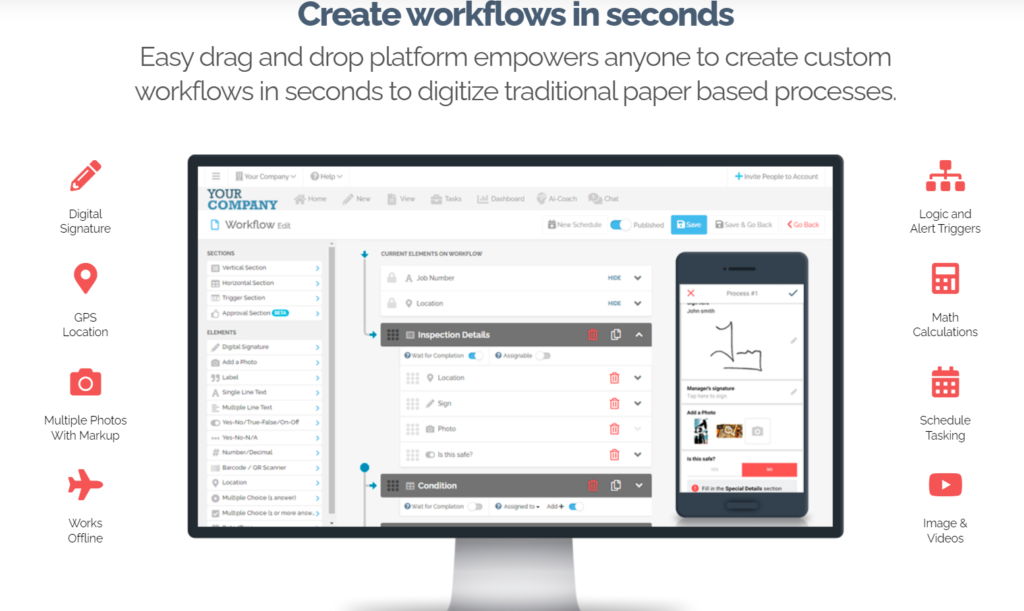In the high-risk environment of the oil and gas industry, safety is paramount. One of the critical standards that ensure fire safety in this sector is NFPA 13.
This article delves into the role and importance of NFPA 13 in oil and gas safety, providing valuable insights and practical solutions to enhance safety protocols. By the end of this article, you will understand why NFPA 13 is indispensable and how digital workflows like FAT FINGER can streamline safety processes.
Request a demo to see how FAT FINGER can revolutionize your safety protocols.
Understanding NFPA 13
NFPA 13, or the National Fire Protection Association Standard for the Installation of Sprinkler Systems, is a comprehensive guideline for designing and installing automatic fire sprinkler systems. Established to minimize fire risks, NFPA 13 is crucial in industries where fire hazards are prevalent, such as oil and gas.
The Scope of NFPA 13
NFPA 13 covers various aspects of fire sprinkler systems, including:
- System design and installation
- Water supply requirements
- Sprinkler head placement
- Maintenance and inspection protocols
These guidelines ensure that fire sprinkler systems are effective in controlling and extinguishing fires, thereby protecting lives and property.
The Importance of NFPA 13 in Oil and Gas Safety
The oil and gas industry is fraught with fire hazards due to the presence of flammable materials. NFPA 13 plays a crucial role in mitigating these risks. Here’s why:
Fire Prevention and Control
NFPA 13 provides a framework for installing fire sprinkler systems that can quickly control and extinguish fires. This is vital in oil and gas facilities where a small fire can escalate rapidly.
Compliance and Legal Requirements
Adhering to NFPA 13 ensures compliance with local and international fire safety regulations. Non-compliance can result in hefty fines and legal repercussions.
Protecting Lives and Assets
Effective fire sprinkler systems protect employees and valuable assets. In an industry where downtime can be costly, preventing fire-related incidents is crucial for operational continuity.
Case Studies Highlighting NFPA 13’s Impact

Several case studies underscore the importance of NFPA 13 in the oil and gas industry:
Case Study 1: Offshore Oil Rig
An offshore oil rig experienced a fire due to a gas leak. Thanks to the NFPA 13-compliant sprinkler system, the fire was quickly contained, preventing a catastrophic explosion. This incident highlights the life-saving potential of adhering to NFPA 13 standards.
Case Study 2: Refinery Fire
A refinery fire caused by an equipment malfunction was swiftly controlled by an NFPA 13-compliant sprinkler system. The quick response minimized damage and downtime, saving the company millions in potential losses.
Challenges in Implementing NFPA 13
While NFPA 13 is essential, implementing it can be challenging. Common obstacles include:
- Complexity of guidelines
- High installation and maintenance costs
- Ensuring regular inspections and compliance
These challenges necessitate a streamlined approach to safety management, which is where digital solutions like FAT FINGER come into play.
Streamlining NFPA 13 Compliance with FAT FINGER

FAT FINGER offers digital workflows that simplify compliance with NFPA 13. Here’s how:
Take 5 Safety
Take 5 Safety checklists ensure that all safety protocols are followed before starting any task. This proactive approach minimizes risks and ensures compliance with NFPA 13.
Near Miss Reporting
Near Miss Reporting allows employees to report potential hazards before they escalate. This feature helps identify and mitigate risks, ensuring a safer work environment.
Job Hazard Analysis
Job Hazard Analysis (JHA) identifies potential hazards associated with specific tasks. By integrating JHA with NFPA 13 guidelines, companies can ensure that all fire risks are addressed.
Risk Assessment
Risk Assessment tools in FAT FINGER help evaluate the likelihood and impact of fire hazards. This data-driven approach ensures that all risks are adequately managed.
Incident Reporting in the Workplace
Incident Reporting features allow for quick documentation and analysis of fire-related incidents. This ensures that lessons are learned and future risks are mitigated.
Journey Report
Journey Reports track the movement of personnel and equipment, ensuring that all safety protocols are followed during transit. This is crucial in the oil and gas industry, where transportation of flammable materials is common.
Conclusion
NFPA 13 is indispensable for ensuring fire safety in the oil and gas industry. While implementing its guidelines can be challenging, digital solutions like FAT FINGER offer a streamlined approach to compliance. By leveraging FAT FINGER’s powerful safety checklists, companies can enhance their safety protocols, protect lives and assets, and ensure operational continuity.
Ready to revolutionize your safety protocols? Create a safety workflow for free on FAT FINGER or request a demo today.

